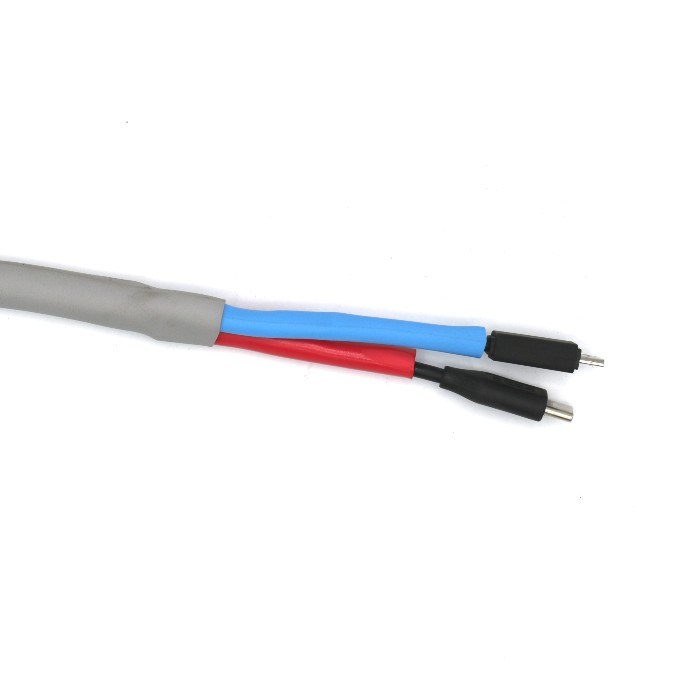- Home
- Resource Center
- Y Shaped Heat Shrink
Y Transitions - Heat Shrinkable Tubing
How To Make A Y-Transition With Heat Shrink Tubing
Making your own Y Transition cable breakout is an easy and cost-effective wire routing solution that can be accomplished using heat shrink tubing and a few common materials. Follow this simple tutorial below to save money with this simple wiring solution.
How To Use A Heat Shrink Y-Transition?
Here is a common example of a wiring scenario where you would need to make a quick Y-Transition: Imagine you have an audio cable and a CAT-5 (a CAT-5 is a twisted pair cable for computer networks) running through the same channel and you need to split them off to create separation between the channels because the audio channel is sensitive to the CAT-5 noise. Instead of buying an expensive Y-transition, we'll make one!
Items Used:
- Wire #1: USB Plug 3/8" x 1/4" (1/8" OD wire). This is the lower one in all the pictures below
- Wire #2 USB Plug 7/16" x 1/4" (3/32" OD wire). This is the upper one in all the pictures below
- 1/2" ID 2:1 Polyolefin Orange Heat Shrink
- 1/2" ID 2:1 Polyolefin White Heat Shrink
- 5/16" ID 2:1 Shiny Clear Heat Shrink Tubing
- VT-1100 Heat Gun
Instructions:
1) Select the appropriate sized tubing for your application. Keep in mind, you have to get it over the connectors but you may want a snug fit on the wire.. In this example, we used 1/2" (Red) 2:1 heat shrink because the plug from wire #2 would not fit through any smaller tubing. 3:1 Polyolefin is a better choice if you want it to be more snug on the wire. Note, we used 3 different types/colors of heat shrink tubing in this illustration to show some different options. It's quite suitable for us to have used the same tubing (and color) for all three parts. If you're unsure, contact us for a recommendation
2) Cut a V-shaped hole in the tubing so the other wire can be pushed out. Place the tubing on the other wire once it's through the V hole. Shrink this one first as seen in Picture #3



3) Slide the wire back so that the shrunk heat shrink is inside the unshrunk heat shrink tube and shrink the second piece


4) For a better finished look, it's recommended you use another piece on top of the split like in the pictures below


Find out about an economy Heat Gun. It has two air speeds, and a temperature control dial for temperatures ranging from 250° to 1100°F
Y Shaped Heat Shrink

Category
-
Heat Shrink & Non-Shrink Tubing
- General Purpose (Single Wall)
- Adhesive Lined Heat Shrink (Dual Wall)
- 3:1 Thin Wall Adhesive Lined (7 Colors)
- 4:1 Adhesive Lined Heat Shrink
- 3:1 Heavy Wall Adhesive Lined Heat Shrink
- 3:1 Medium Wall Adhesive lined heat shrink
- 2:1 Adhesive Lined Heat Shrink
- High ratio (6:1) heat shrink tubing
- Cable TV Adhesive Lined Heat Shrink
- Heat Shrink End Caps
- Heat Shrink Tape
- 3:1 Semi Rigid Adhesive Lined
- High Temperature and Chemical Resistant
- Heat Shrink Kits and End Caps
- Ultra Thin Wall and Low Shrink Temperature (80C)
- Heat Shrink Printing
- Butt Splice Connectors and Electrical Terminals
- Heat Shrink Bands
- EMI/RFI Shielding Heat Shrink
- Non-Shrink Plastic Tubing
- Dunbar Heat Shrink
- 3M™ Heat Shrink Tubing
- Canusa
- Overstock Heat Shrink
- Braided Sleeving
- Cable Ties
- Label Makers & Heat Shrink Printers
- Heat Guns & Tubing Cutters
- Resource Center
- Shop By Industry
- Shop By Brand